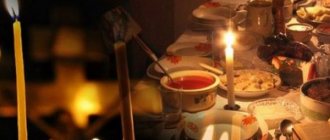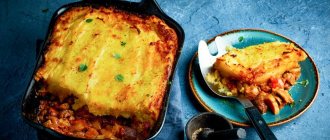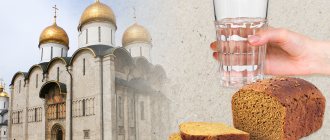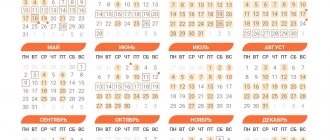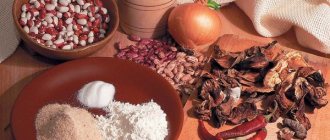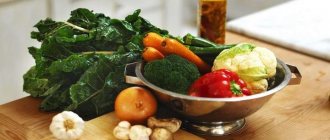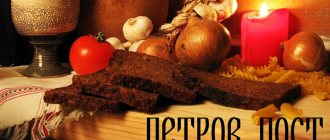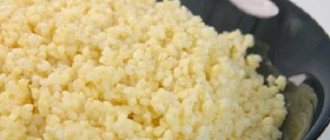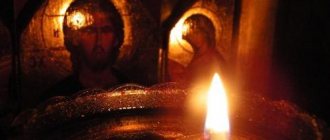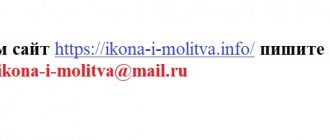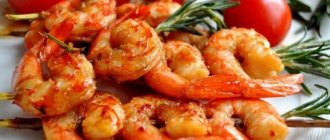Fasting is a time of abstaining from eating food of animal origin and spiritual cleansing of a person (visiting temples and reading prayers, refraining from quarrels and irritability). This period is accompanied by a refusal of all entertainment: visiting cinemas, watching entertainment programs, listening to cheerful music, going on visits, etc.
Attention! Below are the nutritional rules for lay people - ordinary people. They are milder than for monks and contain three degrees of fasting: food without meat, fasting and strict fasting. To determine the severity of your fast, consult your priest.
Orthodox fasting calendar 2022
To find out what fast it is now, you need to open the church calendar. According to the rules of the Russian Orthodox Church, 4 long multi-day abstinence from food are planned for the 22nd year:
- 03/07-23/04 – Lent is the strictest fast in 2022. It lasts 48 days: includes 6 weeks of Pentecost and Holy Week before the Great Solemnity. The meaning of holy fasting and spiritual cleansing during it: preparation of the laity for Easter Sunday.
- 06.20-11.07 - the time of Peter's fast, which annually begins a week after the celebration of the Holy Trinity. It is scheduled for the summer months and will last 22 days in 2022.
- 08.14-27.08 – Lent in August, which in Russia is called Uspensky. It lasts for 2 weeks and serves as preparation for the laity for the Great Solemnity of the Assumption.
- 28.11-06.01 – time of multi-day Christmas abstinence from food, which lasts 40 days. By observing it, believers cleanse their body and soul of everything unnecessary and thereby prepare for the celebration of the Nativity of Christ.
In 2022, things will be like this with one-day posts:
- 18.01 – Orthodox Christians will celebrate Epiphany Eve; on this day it is allowed to consume only food that has undergone heat treatment with the addition of oil.
- 11.09 – one-day abstinence, which was established on the day of the Beheading of the Baptist of the Lord.
- September 27 – refusal of fast food, which occurs on an Orthodox celebration dedicated to the discovery of the Life-Giving Cross.
During the period between church fasts in 2022, it is recommended to abstain from animal products on Wednesdays and Fridays. This should be done at the time when the fast ends and before the next multi-day abstinence begins. At the same time, on major church celebrations that fall on Wednesday and Friday, the laity can eat fish.
The church calendar has 5 Continuous Weeks, which will take place on the following dates:
- January 7 - January 17, 2022
- February 14 - February 19, 2022
- February 28 - March 06, 2022
- April 25 - April 30, 2022
- June 13 - June 19, 2022
A synonym for Solid is omnivorous week (week). At this time, the laity do not abstain from fast food. With the permission of the Orthodox Church, they can consume animal products even on Wednesdays and Fridays.
Detailed food calendar, which is recommended to be followed in 2022:
| What they observe | Monday | Tuesday | Wednesday | Thursday | Friday | Saturday | Sunday |
| Easter Lent (Lent) 07.03-23.04 | Dry eating allowed | Food that has undergone thermal treatment. processing, without oil | Dry eating allowed | Food that has undergone thermal treatment. processing, without oil | Dry eating allowed | Food that has undergone thermal treatment. processed, with oil | Food that has undergone thermal processing. processed, with oil |
| Spring meat eater 20.06-11.07 | Fish day | Fish day | |||||
| Apostolic Fast (Peter's Fast) | Products that have undergone thermal treatment. processing, without oil | Products: fish | Dry food | Fish dishes | Dry food | Fish | Fish dishes |
| Summer meat eater | Dry eating allowed | Dry eating allowed | |||||
| Dormition post 14.08-27.08 | Dry eating allowed | Products that have undergone thermal treatment. processing, without oil | Dry food | Products that have undergone thermal treatment. processing, without oil | Dry food | Food that has undergone thermal treatment. treatment, diluted with oil | Food that has undergone thermal processing. processed, with oil |
| Autumn meat eater | Dry food | Dry products | |||||
| Christmas post 28.11-06.01 Three periods: 28.11-19.12 20.12-01.01 02.01-06.01 | Products that have undergone thermal treatment. processing, without oil | Dishes made from fish | Dry products | Dishes made from fish | Dry food | Fish dishes | Fish |
| Food that has undergone thermal treatment. processing, without oil | Products that have undergone thermal treatment. processed, with oil | Dry food allowed | Food that has undergone thermal processing. processed, with oil | Dry food allowed | Fish day | Fish day | |
| Dry eating allowed | Food that has undergone thermal treatment. processing, without oil | Dry food | Food that has undergone thermal processing. processing, without oil | Dry products | Dishes that have undergone thermal treatment. processed, with oil | Dishes that have undergone thermal treatment. processed, with oil | |
| Winter meat eater | Dishes made from fish | Dishes made from fish |
So how many fast days are there in a year? They number from 178 to 212, the number depends on the severity of abstinence and the health of the person.
Why is Lent necessary?
During Lent, a person is given the opportunity to:
- cleanse your body
of the excess load of heavy food (meaning animal products, which most of us abuse, and which inevitably leads to illness and suffering) - cleanse the soul of the “stones”
that have accumulated on it over the previous year (repent before God and people) - and also strengthen your spirit
in order to become closer to the Lord God, without being distracted by worldly pleasures and burdens (pray, directing your thoughts to the Almighty, and also simply observe fasting - which is oh how difficult...)
These are the main motives of Easter Lent. Naturally, you can comment and interpret each of the points for a long time. But not here and not now.
Lenten soup recipes
Meatless soups for Easter Lent and fasting days
View recipes
Recipes for Lenten main courses
Complete side dishes and main dishes without animal products!
View recipes
Lenten baking recipes
Bright Lenten baked goods for Lent and beyond...
View recipes
Post in January 2022
- Which dates in the first month of the year are considered fast: from 1, 2, 3, 4, 5, 6, 18, 21, 26, 28.
- Great celebrations in January fall on traditionally fast days (Holy Nativity, Circumcision of the Lord are celebrated on Friday, Epiphany on Wednesday). Therefore, abstinence from food will not be recommended.
- On what dates in January should you adhere to strict fasting: 5, 6, 18.
- What you can eat 1, 2, 3, 4, 21, 26, 28: fish and seafood are allowed.
- Lay people eat dry, uncooked food 3, 5, 6.
Children are not recommended to follow these rules. It is enough to limit their consumption of large amounts of sweets.
Christmas post
Lay people begin 2022 with dietary restrictions, which they began to observe at the end of November of the previous year. During the first six days of the new year, believers abstain from fast food.
Lenten menu, what to cook for the table
Fasting is not the time when you need to indulge in excesses and delicacies in food. However, food should be varied and healthy. We offer you several recipes for the Lenten menu that can be used for preparing breakfast, lunch and dinner. Hearty and delicious baked goods will complement your diet.
Breakfast
Breakfast allows you not to feel hungry for a long time, so it is better not to skip this meal. For a morning meal, recipes that take a minimum of time to prepare are suitable.
Quick Lenten pancakes
This recipe does not use eggs or milk, but the pancakes still turn out delicious. They are prepared with brewed tea.
To prepare breakfast for two you will need:
- 1 glass of black or green tea;
- 6 tbsp. l. with a heap of wheat flour;
- 2-3 tbsp. l. granulated sugar;
- 1 tbsp. l. vegetable oil;
- 1 tsp. baking powder;
- on the tip of a tsp. vanillin;
- a pinch of salt.
Warm brewed tea is poured into a bowl, salt, sugar, vanillin, and vegetable oil are added there. Mix the mixture thoroughly. Then pour the sifted flour into a bowl and beat the mixture with a whisk, breaking up all the lumps. At the last stage, baking powder is added (you can use slaked soda). The dough is mixed again and the pancakes are baked in a hot frying pan greased with vegetable oil on both sides. You can serve pancakes with honey or jam.
Rice porridge with pumpkin in a slow cooker
Even those who don't like pumpkin will love the flavor in this recipe. Rice porridge with pumpkin is a great meatless breakfast option. The dish can also serve as a side dish for fish. The ingredients in the recipe are for six servings:
- 600 g rice;
- 1 PC. onions;
- 1 PC. carrots;
- 300-400 g pumpkin;
- 2 tbsp. l. vegetable oil;
- salt and spices to taste.
Peeled onions are cut into cubes, carrots are grated on a coarse grater. Pour vegetable oil into the multicooker bowl and place vegetables there. Fry the onions and carrots for 2-3 minutes, stirring. The rice is washed and soaked in warm water. The kettle is boiling. The pumpkin pulp is cut into cubes and added to the bowl with the onions and carrots.
Rice, salt and spices are added at the same time. The ingredients are mixed and poured with boiling water. There should be enough water so that its level is 1.5 cm above the food layer. After this, close the multicooker lid. For cooking, select the “milk porridge/cereals” program. Cooking time – 60 minutes.
Dinner
If fasting regulations allow, you can prepare vegetable or mushroom soup for lunch, serve pasta with vegetables or seafood, potato casserole, or pilaf with dried fruits.
Vegetable soup with champignons
Champignons fried with soy sauce give this light and healthy dish a special taste. Any vegetables you have in the house are suitable for making soup. The more ingredients, the richer the taste of the finished dish.
To prepare soup for 2 people you will need:
- 200 g broccoli;
- 80 g green beans;
- 90 g champignons;
- half a sweet pepper;
- 1-2 pcs. tomatoes;
- 1 PC. carrots;
- 1 PC. onions;
- 2 tbsp. l. soy sauce;
- 1-2 tbsp. l. vegetable oil;
- salt and black pepper to taste;
- a little fresh dill.
You can use both fresh and frozen vegetables. Broccoli is disassembled into inflorescences, other vegetables are cut into cubes, and champignons are cut into slices. To begin with, pour a little vegetable oil into a frying pan and fry the champignons; add soy sauce at the end of frying. Place carrots and onions in a thick-bottomed pan, season them with salt and pepper, and fry in vegetable oil. Then add sweet peppers, and after 3 minutes tomatoes.
At the next stage, pour 0.5 liters of water into the pan and bring to a boil. After 10 minutes, add green beans and broccoli to the soup and add salt. After 5 minutes, add finely chopped greens to the bowl. Lastly, add the fried mushrooms. Bring the soup to a boil and remove from heat. The dish should sit for 10 minutes. After this, the soup can be served.
Lenten pickle with pearl barley
Vegetable pickle without meat is very easy on the stomach. Pearl barley and potatoes add richness to this dish.
To prepare 8 servings of pickle you will need:
- 4-5 pcs. potatoes;
- 3-4 pcs. pickled cucumbers;
- 1 PC. carrots;
- 1 PC. onions;
- 0.5 cups pearl barley;
- 1-2 tbsp. l. tomato paste;
- salt and black pepper to taste;
- some greenery;
- 1 PC. bay leaf;
- 2 tbsp. l. vegetable oil;
- 2.5 liters of water.
Pour and boil water into a saucepan, throw in diced peeled potatoes. It is better to cook pearl barley separately; it is cooked for about an hour. To get a slimy broth, you can cook pearl barley in soup. Finely chopped onions and grated carrots are fried in vegetable oil for 4-5 minutes, then diced pickles are added to the frying pan, and tomato paste should be added at the end of frying.
After 1-2 minutes, the frying is placed in a pan. Separately cooked pearl barley is added to the soup at the same stage. After this, the dish needs to be salted, pepper, bay leaf and cooked under the lid for 8-10 minutes. At the end of cooking, add finely chopped herbs and turn off the pickle. The finished soup should sit for 10-12 minutes.
Dinner
There are many different dishes you can prepare for dinner. Mushroom, cereal and vegetable cutlets, stuffed peppers with lean filling, and various types of salads are suitable. When you can't use oil, you can simply roast the vegetables in the oven.
Millet cutlets with tomato
Despite their simple composition, the cutlets turn out to be very appetizing, aromatic, with a crispy crust. The recipe is quite budget-friendly; it does not require the purchase of expensive ingredients.
To prepare for 6-7 servings you will need:
- 200 g millet cereal;
- 1 PC. onions;
- 2 tbsp. l. tomato paste;
- 1 tsp. curry seasonings;
- 0.5 tsp. ground paprika;
- 3-4 tbsp. l. vegetable oil;
- 3-4 cloves of garlic;
- 100 g breadcrumbs;
- salt to taste;
- 600 ml water.
The millet needs to be rinsed well several times, then filled with cold water and placed on the stove. As soon as the cereal boils, salt it, reduce the heat and cook the millet until soft. Meanwhile, place finely chopped onion and garlic in a frying pan and fry them in vegetable oil until tender.
Before the end of frying, add curry and paprika. Place onions, garlic and spices into the cooled millet porridge, add tomato paste and mix. After this, cutlets are formed with wet hands, rolled in breadcrumbs and fried until golden brown.
Salad "Mosaic"
This salad is not only healthy and tasty, but also lifts your spirits with its bright appearance. The snack consists of available ingredients.
To prepare you will need:
- 1 PC. carrots;
- 1 PC. beets;
- 2 pcs. potatoes;
- 1 can of canned corn;
- 1 PC. onions;
- 2 tbsp. l. vegetable oil;
- 1/3 tsp. Art. vinegar;
- a small bunch of parsley;
- salt to taste.
Carrots, potatoes and beets must be boiled in their skins until tender. Beetroot takes the longest to cook (large beets - about an hour). After cooking, vegetables need to be cooled, peeled and cut into cubes. The prepared ingredients are mixed with canned corn (the liquid from the can must be drained). Then finely chopped onions and greens are added to the salad. After this, all the ingredients are mixed, salted to taste, seasoned with vinegar and oil.
Bakery
Baking during Lent is an excellent dessert option. These can be various pies and pies, bagels, gingerbread, sweet rolls. We offer you one of the interesting recipes.
Honey cake with raisins and apples
The baked goods are aromatic, soft, and have a spicy taste.
Required ingredients:
- 100 ml coffee;
- 100 g sugar;
- 175 g flour;
- 1 tbsp. l. honey;
- 1 tbsp. l. sunflower oil;
- 1.5 tbsp. l. raisins;
- one apple;
- 0.5 tsp. soda;
- 2 pcs. carnations;
- two pieces. cardamom;
- 1/3 tsp. cinnamon;
- a pinch of nutmeg.
Coffee can be taken from beans or instant. The drink is poured into a small saucepan, honey and sugar are added there. The mixture needs to be heated so that the honey dissolves, but the sugar crystals remain. Then pour in the baking soda and stir quickly. The mass should begin to foam. Now add sifted flour, salt and spices crushed in a mortar.
Knead the dough well, add pre-soaked raisins and pour in sunflower oil. The base for the gingerbread is mixed again. At the last stage, peeled and chopped apples are added to the dough. The mass needs to be mixed again. Bake the Lenten gingerbread in a pan lined with parchment at 180° C (preheat the oven in advance) for 25-30 minutes. Cut the baked goods into portions after they have cooled.
Post in February 2022
Among the fasting dates of the last month of winter are:
- Wednesdays falling on 2, 9, 23;
- Fridays corresponding to the dates 4, 11, 25.
The last day of the calendar winter will mark the beginning of Cheese Week. Starting from the first day of the week, abstinence from animal products is recommended.
March
The first month of spring begins with Cheese Week. It is called pre-purification. The laity gradually begins to prepare the body for the beginning of Lent. In the first week of March, you should completely limit your consumption of meat and animal products.
Lent
An important date for the laity: Lent begins in 2022 - March 7. From this date until the end of the month during Easter Lent, believers will adhere to strict food restrictions.
What can you eat according to the Orthodox calendar, if there are no serious contraindications regarding human health:
- 7.03 – it is recommended to completely abstain from eating;
- dates when you need to stick to dry eating: 8, 9, 10, 11, 14, 16, 18, 21, 23, 25, 28, 30;
- food that has undergone heat treatment, but without adding oil, can be eaten on Tuesdays and Thursdays on the following dates: 15, 17, 22, 24, 29, 31;
- The laity eat food that has undergone heat treatment with the addition of oil on weekends: 12, 13, 19, 20, 26, 27.
Cheese Week - the week before Lent (preparatory)
To prepare for the strict regime of Lent, the church charter suggests a gradual abandonment of the usual rhythm and diet - over the course of a week.
The church name of this week is Cheese Week, the popular name is Maslenitsa.
The important thing here is that Maslenitsa is not a riotous and cheerful time, but a way to gradually prepare for fasting. You shouldn’t eat and drink “like the last time,” because you will have to endure it for a long time. It’s better to gradually move on to simple and light food, because the first week of Lent is oh so difficult...
Recipes for Maslenitsa
Pancakes and pancakes for every taste!
View recipes
April
The lay people's nutrition calendar in April will be limited by strict rules: only food of plant origin is allowed. This month, believers celebrate three great celebrations.
These include:
- Annunciation (7.04),
- Palm Sunday (17.04),
- Bright Resurrection of Christ (24.04).
On April 7 and 17, you can indulge yourself: arrange fish days. 17.04 you can drink a small amount of red wine. April 16 (Lazarev Saturday) you are allowed to enjoy caviar.
Continuation of Lent
Strict abstinence must be adhered to during Lent 2022 on the following dates:
| Dates | What is allowed |
| 1.04 | Dry eating is allowed |
| 2.04 | Cooked food with added oil |
| 3.04 | Cooked food with added oil |
| 4.04 | Dry eating is allowed |
| 5.04 | Cooked food, no oil |
| 6.04 | Dry eating is allowed |
| 7.04 | Fish dishes |
| 8.04 | Dry eating is allowed |
| 9.04 | Cooked food with added oil |
| 10.04 | Cooked food with added oil |
| 11.04 | Dry eating is allowed |
| 12.04 | Cooked food without added oil |
| 13.04 | Dry eating is allowed |
| 14.04 | Cooked food without added oil |
| 15.04 | Dry eating is allowed |
| 16.04 | It is allowed to add caviar to the diet |
| 17.04 | Fish day, glass of wine allowed |
Holy Week
According to the church calendar, Holy Week begins on April 18.
For laypeople under strict restrictions, meals should be planned according to the following rules:
| Dates | What is allowed |
| 18.04 | Dry eating is allowed |
| 19.04 | Dry eating is allowed |
| 20.04 | Dry eating is allowed |
| 21.04 | Cooked food with added oil |
| 22.04 | Eliminate any foods from the diet, only clean water is allowed |
| 23.04 | You can drink water and eat bread |
Holy Sunday, Easter
April 24th is Easter, Bright Sunday of Christ. In Orthodoxy, this day is considered the brightest and most joyful holiday. Christians celebrate the resurrection of the Son of God by gathering around a set table. Before the celebration begins, it is advisable to attend a service in the temple; if this is not possible, be sure to pray at home.
It is believed that on this day saints pay special attention to requests and prayers addressed to them. Lent is over, believers can return to their normal diet. They begin to break their fast in the morning. First of all, you need to try the colored eggs and Easter cake, which are blessed in the temple the day before. On Easter, believers must do a good deed - help the weak, give alms to the needy.
Help must come from the heart and be selfless. On this day you need to avoid sadness, tears and conflicts. Guests are invited to the house, with whom they celebrate the holiday. Of the alcoholic drinks for Easter, Cahors is most suitable.
- Easter Easter cake: recipes with photos step by step in the oven
- Easter cottage cheese: 8 delicious and simple recipes
June 2022: post calendar
In the first month of summer, believers will observe 4 one-day food restrictions, and from June 20 they will begin the important Peter's Fast.
Posts of one day
Schedule of fasts and meals:
On dates falling on Wednesdays and Fridays 1, 3, 8, 10, it is recommended to adhere to mild dietary restrictions. Fish, meat and animal products are prohibited.
Petrov post
Believers can consume fish dishes except for three dates: 22, 24, 29. For those observing strict abstinence on these dates, it is recommended to adhere to dry eating.
October
<<
| ||||||||
| Mon | W | Wed | Thu | Fri | Sat | Sun | ||
For the laity
Meals on the fast days of October in the first and second versions differ only in the degree of severity - laymen are allowed fish, for those living under strict regulations - dry eating is recommended.
According to strict regulations
All Wednesdays and Fridays of the month are strict fasting (dry eating). October 14 (Protection of the Blessed Virgin Mary) - you can eat fish products, poultry and animal meat under the ban.
July
In the second summer month, the laity will celebrate two important celebrations: the Nativity of the Baptist and the day of the two apostles Peter and Paul, for which the Apostolic Fast is preparing.
Petrov fast in July
As for the consumption of animal products, they are prohibited until 11.07. It is allowed to eat fish dishes every day, with the exception of: 1, 6, 8. For people who are strictly abstinent, at this time they need to switch to dry eating.
August 2022: post calendar
Among the great church celebrations it is necessary to highlight: the Holy Transfiguration (08.19) and the Assumption (08.28).
Dormition post
Abstinence from food will begin with the Honey Rescue, which is scheduled for August 14. For two weeks, believers abstain from food of non-plant origin. There will be only one fish day: it falls on the major Transfiguration celebration.
What does strict abstinence look like:
- dry eating is allowed every Wednesday and Friday (except for 19.08);
- On August 15 and August 22, you should also adhere to dry eating;
- heat-treated food without added oil is allowed 16, 18, 23, 25;
- Heat-treated food with added oil is allowed 14, 20, 21, 27.
September
Among the important church celebrations in the first month of autumn are:
- 11.09 – Beheading of the Baptist;
- 21.09 – Nativity of the Mother of God;
- 27.09 – Exaltation of the Holy Cross.
Fast days in September
On every Wednesday and Friday you cannot eat animal products. On the Great Holidays of September 11 and September 27, you are also allowed to eat only plant foods.
If we consider the strict rules, then dry eating is recommended on Wednesdays and Fridays. Fish dishes are allowed on the Nativity of the Mother of God. On September 11 and September 27, heat-treated food with added oil is allowed.
Post in December
Of the important dates, it is necessary to note December 19 - Day of St. Nicholas the Wonderworker (Winter St. Nicholas).
Advent in December
Laymen must follow simple rules in the first winter month: they can eat fish dishes on all days of the month, with the exception of Wednesdays and Fridays (on these days only food of plant origin).
Those who strictly adhere to the regulations should pay attention to the following recommendations:
- dry eating is allowed on Wednesdays and Fridays;
- fish dishes are allowed on weekends and on the following dates: 1, 6, 8, 13, 15, 19;
- heat-treated food with added oil is recommended: 20, 22, 27, 29;
- heat-treated food without oil: 5, 12, 26.
